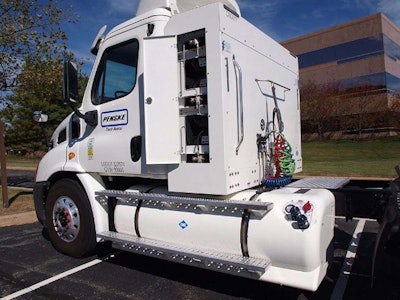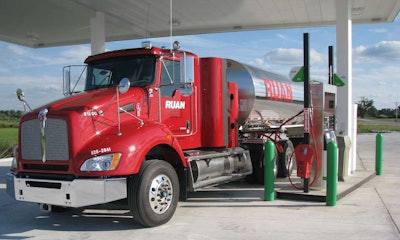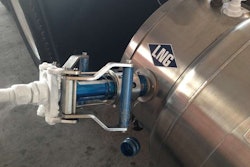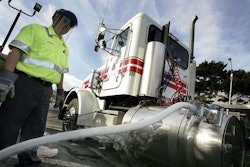Editor’s note: This is the first part of the two-part “Natural gas reality check” series. See Part 2 Tuesday.
 Penske Truck Leasing recently was awarded a $400,000 grant from the U.S. Department of Energy to support the company’s Alternative Fuel Vehicle Demonstration and Enhanced Driver Experience Project. Penske will use the funds to introduce CNG tractors to customers in Wisconsin, Maryland and Louisiana.
Penske Truck Leasing recently was awarded a $400,000 grant from the U.S. Department of Energy to support the company’s Alternative Fuel Vehicle Demonstration and Enhanced Driver Experience Project. Penske will use the funds to introduce CNG tractors to customers in Wisconsin, Maryland and Louisiana.In April 2011, on-highway diesel broke the $4-per-gallon mark for the first time since the recession, double the low of $2-per-gallon just two years earlier. Fleet managers, still reeling from the effects of the economic downturn, were scrambling for answers.
By 2012, there was no bigger buzzword in trucking than natural gas. Whether it was compressed natural gas or liquefied natural gas, OEMs and engine makers were ramping up for what was expected to be a game-changer for trucking efficiency.
By that time, diesel had stabilized at about $4 per gallon, and no one thought it would drop soon. A handful of carriers were quick to react, converting some or most of their fleet equipment to more expensive natural gas-powered tractors to take advantage of the fuel’s comparatively low cost. Many other carriers followed suit, dipping their toes in the water and getting positive results, just as the fueling infrastructure was unfolding.
Other carriers were pressured into natural gas adoption by customers with aggressive environmental sustainability initiatives such as Owens Corning and Procter & Gamble. By December 2013, Class 8 natural gas truck sales had risen from nowhere to account for 3.2 percent of the total U.S. and Canadian Class 8 truck market, according to FTR, an industry analyst firm that tracks equipment and freight trends.
Some were calling for the natural gas truck market to skyrocket at that time, with Thomas O’Brien, TravelCenters of America president and chief executive officer, suggesting that one in four heavy trucks on the road in 2020 would be powered by natural gas.
The diesel dip
Over the next year and a half, diesel plummeted $1.25 per gallon, hitting a low of $2.75 in April of this year, according to the U.S. Energy Information Administration’s weekly retail price index.
Lower diesel costs, coupled with strides made by OEMs and engine makers to improve the fuel economy of traditional diesel-powered trucks and engines, have combined to stymie the natural gas market.
 ampCNG, which owns and operates public-access CNG fueling stations for heavy-duty trucks, announced its fleet of Class 8 CNG trucks has surpassed 30 million miles achieving fuel efficiency of 6.17 miles per diesel gallon equivalent, demonstrating CNG’s commercial and operational viability.
ampCNG, which owns and operates public-access CNG fueling stations for heavy-duty trucks, announced its fleet of Class 8 CNG trucks has surpassed 30 million miles achieving fuel efficiency of 6.17 miles per diesel gallon equivalent, demonstrating CNG’s commercial and operational viability.“We are seeing a leveling off in activity,” said Eric Starks, FTR president. “Demand for natural gas equipment is not growing, nor is it dropping. The trucking industry has been hoping for growth in this sector, and it clearly has stalled out and is not expected to make significant strides until the price of diesel fuel rises again.”
Given the inherent volatility in diesel prices, it is unlikely the low-cost fuel will remain at current levels for a long period of time.
T. Boone Pickens, speaking at ACT Expo in Dallas last month, said as U.S. producers throttle back production, he expects oil prices to recover to upwards of $70 per barrel by the end of this year and approach $90 per barrel by the end of 2016.
“Since 1980, I’ve seen six of these collapses of half the price of oil, and I promise you it will be back up again,” he said, adding that U.S. producers, who at their peak had more than 1,600 rigs drilling for oil, are responsible for the decline in oil prices. But rig counts have been cut by more than half as prices fell.
“We’re the one who oversupplied the market and caused it to drop $50 per barrel,” said Pickens, who then compared the volatility of natural gas and diesel markets.
“If natural gas doubled to $6, it would increase your fuel cost 37 cents per gallon,” he said. “$100 oil in parity with natural gas is $16, and I’ve never seen that. I’ve said that in my lifetime, I don’t think I’ll ever see $10 natural gas again, but I do think we may see $8. But I think you’re looking at $100-plus oil forever.”
Navigating today’s challenges
The natural gas truck market has faced other headwinds during the last year and a half in addition to lower diesel prices. The added costs of natural gas-powered vs. diesel-powered tractors – between $40,000 and $60,000 depending on tank configuration – have been slow to come down. An uncertain future in the used truck market has many fleets sitting on the fence before investing in natural gas equipment.
 T. Boone Pickens expects oil prices to recover to upwards of $70 per barrel by the end of this year and approach $90 per barrel by the end of 2016.
T. Boone Pickens expects oil prices to recover to upwards of $70 per barrel by the end of this year and approach $90 per barrel by the end of 2016.And while many regional and dedicated carriers have had great success with natural gas operations, the fueling infrastructure still is being built out, and many over-the-road carriers remain hesitant to test the waters.
The natural gas truck market took another hit last month when the journal Environmental Science & Technology published the results of a study coauthored by the Environmental Defense Fund that claims methane emissions from the natural gas manufacturing process and supply chain could lead to greater global warming than carbon dioxide emissions from diesel-powered trucks.
According to EDF, methane – the main component of natural gas – has 84 times the warming power of carbon dioxide over a 20-year timeframe.
“Natural gas trucks have the potential to reduce overall climate impacts compared to diesel, but only if we clean up the highly potent greenhouse gas emissions from the systems that produce and deliver the fuel,” said Jonathan Camuzeaux, EDF senior economy analyst. “Otherwise the net warming effect is actually a negative one for 50 to 90 years after the fuel is burned.”
Natural Gas Vehicles for America, a developer for market acceptance of natural gas vehicles, was quick to respond.
“This study clearly demonstrates that there is a role for natural gas in addressing climate change,” said Matthew Godlewski, president of NGVAmerica. “We welcome all credible insight into paths for improving emissions, yet it’s confusing that the Environmental Defense Fund has chosen to conduct and release another study, outside of the cooperative work already underway.”
See Part 2 of the Natural gas reality check series Tuesday.













